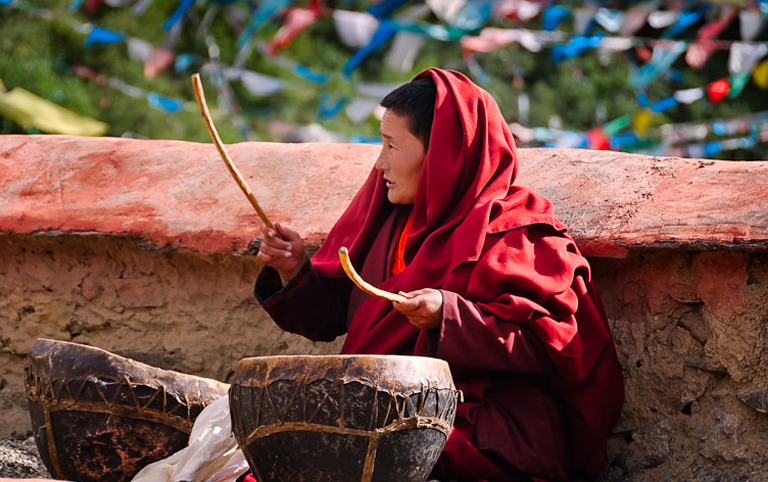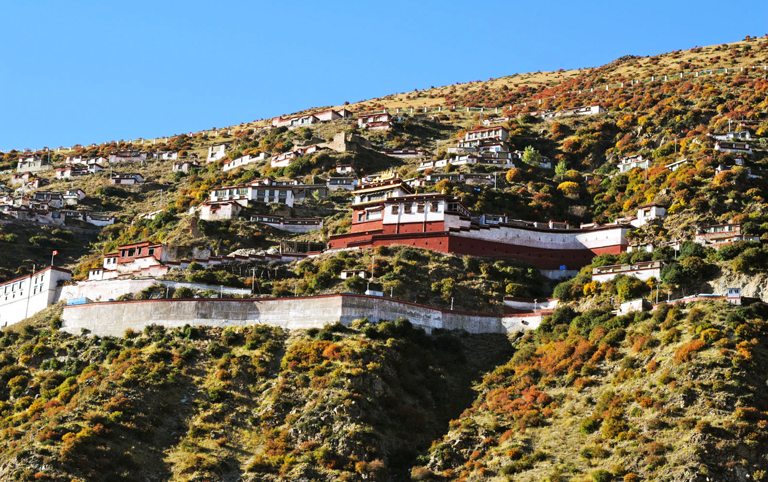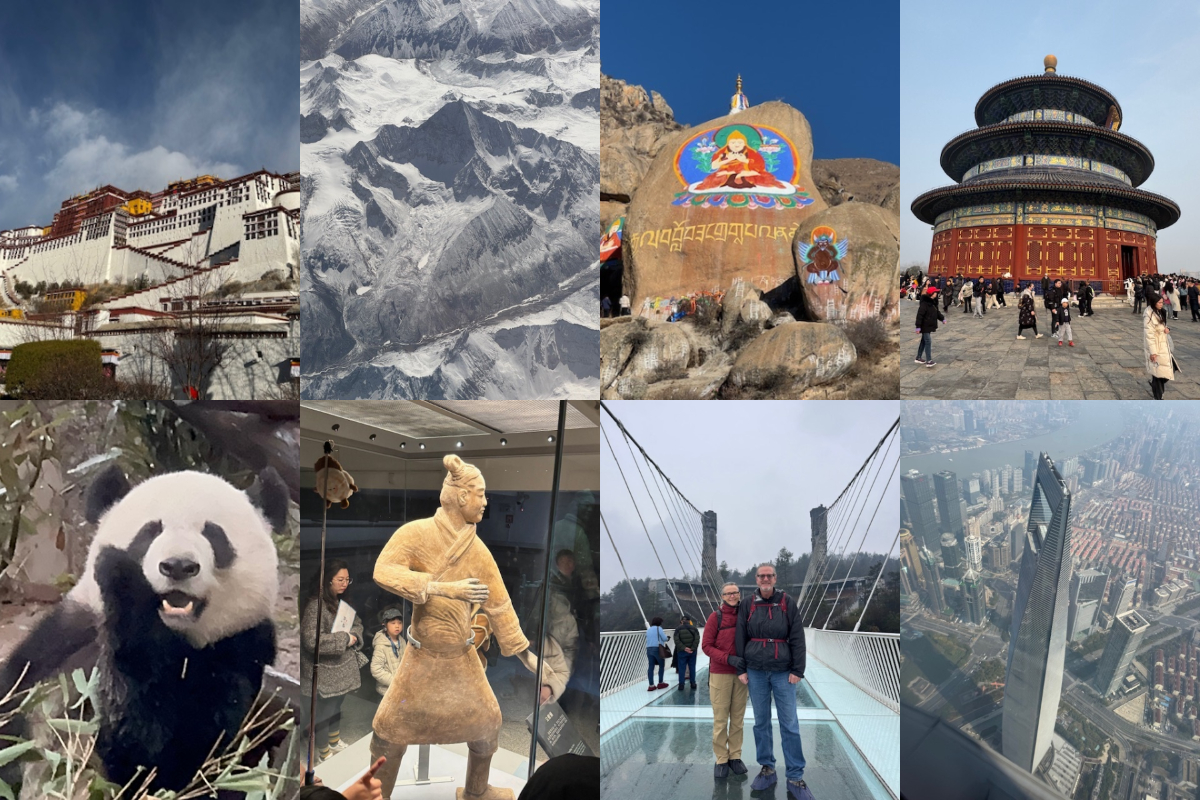Visiting the famous palaces and temples in Lhasa city is the classic traveling in Lhasa. Do you want to add some adventurous experience? - Stunning valleys and hot spring are waiting. In this tour, you won't miss the famous sites in Lhasa, such as Potala Palace, Jokhang Temple, Sera Monastery. But the most special experience to discover the hidden ancient monasteries in the tranquil valleys. If you like, you will also enjoy a relaxing hot spring bath at Tidrum.
Highlights of this tour:
- Climb up the grandiose Potala Palace, one of the most spectacular architectures in the world, and explore its mysterious inner world;
- Soak up the strong Buddhist culture in Jokhang Temple and the three greatest monasteries in Lhasa – Sera Monastery, Drepung Monastery and Ganden Monastery;
- Visit historical Tirdrum Nunnery and holy Dirgung Til which are both hidden in the beautiful valley.
Tour Brief Information
- Tour price: from Request
- Tour code: TD-LT-06
- Tour Type: Private Customizable Tour Package
- Destination: Lhasa / Drigung / Lhasa
- Duration: 6 days and 5 nights
- Departure: Flexible
- Travel Theme:




- Best Time:


- Physical Level
- Tour Pace
- Max Altitude
4,700m
- Itinerary Details
- Price Guide & Booking
- Trip FAQs
- Reviews
- Make an Enquiry
Your tour - at a glance
Day 1~3 Arrival & Lhasa Tour
Day 4~5 Lhasa - Drigung Til - Lhasa
Day 6 Lhasa Departure
Itinerary Details - Day by Day
Day 1 Lhasa Arrival
Welcome to the roof of the world! You will be picked up by local tour guide at the airport hall or train station, and then be escorted to your hotel in Lhasa city in a private vehicle.
After arrival at your hotel, the rest of the day is free for you to explore the local areas and acclimatize yourself to the air, temperature and high altitude of Lhasa.
High Altitude Acclimation Tips: 1) go for some leisure walking to acclimate the high altitude but avoid strenuous activity after arrival; 2) you’d better not have bath, in case of catching a cold; 3) drink more water, and have some fruit; 4) have a good rest.
Day 2 Lhasa ( B )
Start today’s Lhasa exploration with an exciting visit to the landmark - Potala Palace which is regarded as one of the most beautiful architectural building in the world. You will climb up the palace along the zigzag stone paths with white-and-red walls to the top of the palace where you can not only appreciate the exotic Tibetan-style architecture, but also get a great view of Lhasa’s urban areas, then walk into the inner space of Potala Palace to explore the stately chapels and learn about the history of the palace.
Continuing your exploration, you will then get to Jokhang Temple which is considered as the spiritual heart of Tibetan Buddhism. Each day, there are thousands of pilgrims coming from different places in Tibet to the temple to worship to the Buddha. This temple is also known as the “house of Buddha” because it keeps the precious Jowo Rinpoche, the life-sized (5 foot/1.5m) image of the Shakyamuni at the age of 12. The last site for today’s exploration is the famous Barkhor Street. It is a circular and wide street encircling the Jokhang Temple. The local people like to walk on the street for several circles usually in the late afternoon as a daily tradition of pilgrimage. The street also has many shops selling a wide variety of traditional Tibetan goods, religious items and handcrafts.
Tips of Today: 1) there are 1,080 steps up to climb to the top of Potala Palace, so don’t walk in a rush, which may cause high altitude sickness; 2) taking photos is not allowed inside the palace; 3) today you will be mainly outside, please bring some water, a hat, sun cream, and sun glasses with you.
-
 Amazing Potala Palace in the morning
Amazing Potala Palace in the morning
-
 Feast on the great view of Jokhang Temple Square
Feast on the great view of Jokhang Temple Square
-
 Local House by Barkhor Street
Local House by Barkhor Street
Day 3 Lhasa ( B )
After breakfast, you will firstly go to visit the beautiful Norbulingka which used to be the former summer palace of Dalai Lamas in the ancient time, and now is a public park. It is famous for its Potrang, the private palaces of former Dalai lamas with grandiose Tibetan architecture style. Next, drive several kilometers to the western outskirts of Lhasa to visit Drepung Monastery. Drepung, in Tibetan, means “prosperity”. Since its establishment, Drepung Monastery has always been one of the most important Buddhist monasteries in Tibet. In its heyday, there were more than 10,000 monks lived and studied in the monastery. Throughout its history, many important and famous Tibetan leaders used to study here, especially the Dalai Lamas. So Drepung Monastery is also respectfully known as the “Mother School of Dalai Lamas”.
In the afternoon, you will be taken to another famous monastery in Lhasa - Sera Monastery. It is famous for the spectacular “Buddhism Debating”. As a daily routine, the monks gather in a courtyard, and debate on the Buddhist doctrines with supplemented gestures, which is thought to be helpful to facilitates better comprehension of the Buddhist philosophy to attain higher levels of study. After enjoying the "Buddhism Debating", you will be transferred back to the city. The rest time is your own free time to rest.
The Etiquette of Visiting Monastery: 1) you shouldn’t wear short and uncover shoulders; 2) taking off your sunglasses and hat before entering the chapels; 3) taking photos is usually not allowed inside the chapels.
-
 Buddhism Debating Scripture with dramatic gestures in Sera Monastery
Buddhism Debating Scripture with dramatic gestures in Sera Monastery
-
 Six-letter Mantra Rock Painting
Six-letter Mantra Rock Painting
-
 Pay a visit to the Dalai's Summer Palace - Norbulingka
Pay a visit to the Dalai's Summer Palace - Norbulingka
Day 4 Tidrum Nunnery ( B )
Today, you will get out of Lhasa city to Tidrum Nunnery, about 140km away from Lhasa city, which is also famous for the Tidrum Hotspring nearby. Before you get to the Tidrum, you will have a short visit to the famous Ganden Monastery, the ancestral monastery of Gelug Sect of Tibetan Buddhism founted by the master Tsongkapa.
Tidrum Nunnery’s history can be traced back to the 8th century when the Tantric master Padmasambhava once meditated in a cave near to today’s nunnery. It is also said that the wife of Tibetan King Trisong Detsen – Yeshe Tsogyal used to meditate here also in a cave around. But the first temple for Buddhism was built in 1281. Today, it is a peaceful and sacred nunnery for 120 Buddhist nuns.
The Tidrum Hotspring, close to the nunnery, is very popular with convalescing Tibetans and travelers. It has be improved that the hotspring water is rich in minerals which can help to cure diseases from rheumatism to paralysis.
Tips: 1.one should consult doctor to check whether his/her healthy condition is suitable for hotspring bathing; 2. Taking photos is not allowed in the spring area even if no one is in the pool.
-
 Quiet Ganden Monastery
Quiet Ganden Monastery
-
 A Buddhist nun in Tidrum Nunnery
A Buddhist nun in Tidrum Nunnery
Day 5 Drigung Til - Lhasa ( B )
Get up early to see the beautiful sunrise in the tranquil valley of Tidrum. Then you will move to explore a unique holy monastery – Drigung Til.
Drigung Thil Monastery was built by Jigten Sumgon in 1179, which established the famous Drigung Kagyu Tradition of Tibetan Buddhism. The monastery is famous for its meditation study with meditators living and meditating in nearby caves, and site for sky burial. There is a college in the monastery where the monks will spend five years finishing the study on sutra and tantra subjects. In the annual Tibetan New Year, thousands of pilgrims come from far distance to worship here. There are more than fifty buildings housing about 250 monks so far. From the monastery, you can get a wonderful panoramic view of the front valley.
In the afternoon, you will be transferred back to Lhasa along the coming way.
Pleae note: the sky burial site is not open for tourists.
-
 Magnificent Drigung Monastery was built on the hillside
Magnificent Drigung Monastery was built on the hillside
Day 6 Lhasa Departure ( B )
Today is free for you until your tour guide transfer you to the airport in time for your flight or drop you off at Lhasa train station.
Tips of today: 1. Please pack your luggage carefully, especially for small things like camera charger, power adaptor, mobile phone, phone charger, wallet and towel. 2. If your flight is arranged in the afternoon, please make sure you check out the hotel before 12pm.
Useful Trip Notes
-
- 1. Tibet Permits Guaranteed
To travel in Tibet, all Non-Chinese passport holders need to have a Tibet Travel Permit which is issued by Tibet Tourism Bureau in Lhasa. And only Chinese travel agencies like Tibet Discovery can apply for the permit on behalf of tourists. You must obtain it before your tour starting because the permit will be checked when you board your flight/train to Tibet. Traveling with Tibet Discovery, you don't have to worry about the complicated procedures of Tibet Travel Permit application. All you have to do is to confirm a tour package with us and send us your passport and Chinese visa copies at least 15~20 days in advance before your tour, then we will take care of all the rest things. Once the permit is issued, we will deliver to your address in China, such as your hotel, local travel agency, etc.
-
- 2. Available Months to Visit Tibet
Generally speaking, April to October is the best time. July and August are the peak season and rainy season. It is usually snowy and cold in winter, which is not suitable for visit Mount Everest, Namtso and Mount Kailash regions. While other places such as Lhasa, Gyantse and Shigatse are suitable for travel all year around. The temperatures in daytime and night differs a lot, usually 5~15℃ in the daytime and -5~0℃ in the night, so please wear accordingly.
-
- 3. High Altitude Sickness
The average altitude of Tibet is about 4000 meters above the sea level (Lhasa: 3700m; EBC: 5200m; Namtso: 4718m). You may suffer a bit from High Altitude Sickness in the beginning days of your Tibet trip if you haven’t had rich high plateau travel experience. But don’t worry too much, the high altitude can be acclimatized usually in 2~3 days. Our suggestion is to take a physical examination and get suggestions from your doctor, and also bring some medicines to prevent from High Altitude Sickness before your trip. While in Tibet, you should keep warm all the time, avoid strenuous activities, drink more water and eat more vegetables and carbohydrates. You’d better not take showers during the first two days after your arrival in Tibet. If you don’t feel well, get help from your tour guide or go to the hospital without any delay.
-
- 4. How to Go to Tibet
Basically you have two options – flight and train. Currently, you can take a flight to Lhasa from Beijing(4.5hrs), Xian(3.7hrs), Chengdu(2.5hrs), Chongqing(3hrs), Kunming(3hrs), Kathmandu (1.5hrs), etc. Among all these cities, Chengdu and Xian have more frequent flights to Lhasa.
If you prefer a train travel, you can take a train to Tibet from Beijing(40.5hrs), Xian(32hrs), Chengdu(43hrs), Shanghai(47hrs), Chongqing(42hrs), Lanzhou(25hrs), Xining(22hrs), Guangzhou(54hrs). -
- 5. Packing and Wearing Ideas
Firstly you can’t forget your passport and Chinese Visa. A large backpack and a smaller one are recommended (the smaller one can be used for daily activities). Also bring necessary medicine you need. Other stuffs like sunglasses, snow glasses, hats, lip balm, sun block are recommended.
As for wearing, you are suggested to dress in layers (both thin and thick jackets). Down jacket is necessary in Spring and Autumn. A pair of durable and comfortable shoes is necessary.
Recommended Tibet Group Tour Packages
Escorted by a skilled driver and companied by a professional local tour guide to organize all the activities, all you have to do is to enjoy your fantastic Tibet journey.Following are some other recommended Tibet group tour packages that you may be interested in. You can also contact us to customize a trip if you want..
-

Lhasa
4 Days Lhasa City Private Tour - Heart of Tibet
Highlights: Potala Palace, Barkhor Street, Sera Monastery
-

Lhasa / Namtso / Lhasa
5 Days Lhasa Highlights & Holy Lake Namtso Tour
Highlights: Potala Palace, Barkhor Street, Sera Monastery, Namtso Lake
-

Tsetang / Lhasa
6 Days Shannan Highlights Tour
Highlights: Potala Palace, Yumbulakang, Samye Monastery







 Karen
Karen Wonder
Wonder Jack
Jack Rita
Rita Johnson
Johnson Vivien
Vivien Wing
Wing Ariel
Ariel Leo
Leo Tracy
Tracy Evelyn
Evelyn April
April Phoebe
Phoebe Kelly
Kelly Shirley
Shirley Reya
Reya Juliet
Juliet Elk
Elk Felix
Felix Sean
Sean